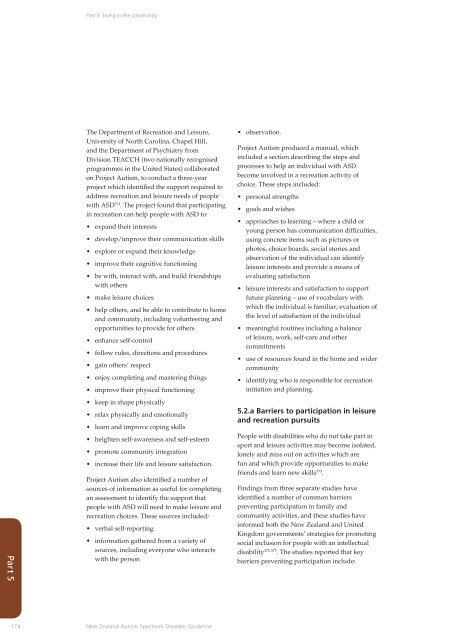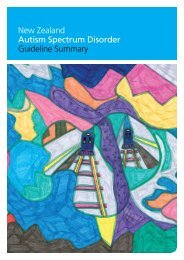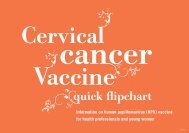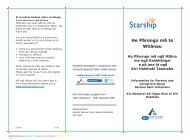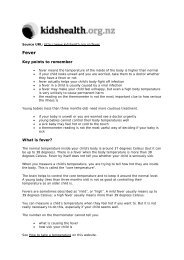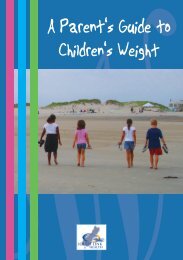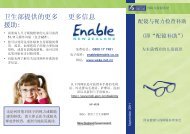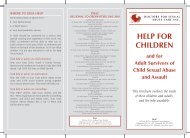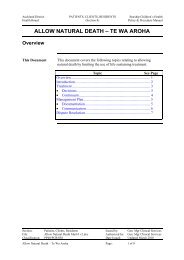New Zealand Autism Spectrum Disorder Guideline - Ministry of Health
New Zealand Autism Spectrum Disorder Guideline - Ministry of Health
New Zealand Autism Spectrum Disorder Guideline - Ministry of Health
You also want an ePaper? Increase the reach of your titles
YUMPU automatically turns print PDFs into web optimized ePapers that Google loves.
Part 5: Living in the community<br />
Part 5<br />
The Department <strong>of</strong> Recreation and Leisure,<br />
University <strong>of</strong> North Carolina, Chapel Hill,<br />
and the Department <strong>of</strong> Psychiatry from<br />
Division TEACCH (two nationally recognised<br />
programmes in the United States) collaborated<br />
on Project <strong>Autism</strong>, to conduct a three-year<br />
project which identified the support required to<br />
address recreation and leisure needs <strong>of</strong> people<br />
with ASD 374 . The project found that participating<br />
in recreation can help people with ASD to:<br />
• expand their interests<br />
• develop/improve their communication skills<br />
• explore or expand their knowledge<br />
• improve their cognitive functioning<br />
• be with, interact with, and build friendships<br />
with others<br />
• make leisure choices<br />
• help others, and be able to contribute to home<br />
and community, including volunteering and<br />
opportunities to provide for others<br />
• enhance self-control<br />
• follow rules, directions and procedures<br />
• gain others’ respect<br />
• enjoy completing and mastering things<br />
• improve their physical functioning<br />
• keep in shape physically<br />
• relax physically and emotionally<br />
• learn and improve coping skills<br />
• heighten self-awareness and self-esteem<br />
• promote community integration<br />
• increase their life and leisure satisfaction.<br />
Project <strong>Autism</strong> also identified a number <strong>of</strong><br />
sources <strong>of</strong> information as useful for completing<br />
an assessment to identify the support that<br />
people with ASD will need to make leisure and<br />
recreation choices. These sources included:<br />
• verbal self-reporting<br />
• information gathered from a variety <strong>of</strong><br />
sources, including everyone who interacts<br />
with the person<br />
• observation.<br />
Project <strong>Autism</strong> produced a manual, which<br />
included a section describing the steps and<br />
processes to help an individual with ASD<br />
become involved in a recreation activity <strong>of</strong><br />
choice. These steps included:<br />
• personal strengths<br />
• goals and wishes<br />
• approaches to learning – where a child or<br />
young person has communication difficulties,<br />
using concrete items such as pictures or<br />
photos, choice boards, social stories and<br />
observation <strong>of</strong> the individual can identify<br />
leisure interests and provide a means <strong>of</strong><br />
evaluating satisfaction<br />
• leisure interests and satisfaction to support<br />
future planning – use <strong>of</strong> vocabulary with<br />
which the individual is familiar; evaluation <strong>of</strong><br />
the level <strong>of</strong> satisfaction <strong>of</strong> the individual<br />
• meaningful routines including a balance<br />
<strong>of</strong> leisure, work, self-care and other<br />
commitments<br />
• use <strong>of</strong> resources found in the home and wider<br />
community<br />
• identifying who is responsible for recreation<br />
initiation and planning.<br />
5.2.a Barriers to participation in leisure<br />
and recreation pursuits<br />
People with disabilities who do not take part in<br />
sport and leisure activities may become isolated,<br />
lonely and miss out on activities which are<br />
fun and which provide opportunities to make<br />
friends and learn new skills 375 .<br />
Findings from three separate studies have<br />
identified a number <strong>of</strong> common barriers<br />
preventing participation in family and<br />
community activities, and these studies have<br />
informed both the <strong>New</strong> <strong>Zealand</strong> and United<br />
Kingdom governments’ strategies for promoting<br />
social inclusion for people with an intellectual<br />
disability 375-377 . The studies reported that key<br />
barriers preventing participation include:<br />
174<br />
<strong>New</strong> <strong>Zealand</strong> <strong>Autism</strong> <strong>Spectrum</strong> <strong>Disorder</strong> <strong>Guideline</strong>


